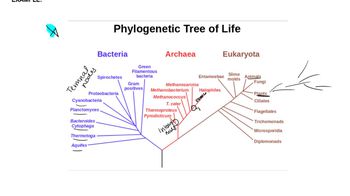Table of contents
- 1. Introduction to Genetics51m
- 2. Mendel's Laws of Inheritance3h 37m
- 3. Extensions to Mendelian Inheritance2h 41m
- 4. Genetic Mapping and Linkage2h 28m
- 5. Genetics of Bacteria and Viruses1h 21m
- 6. Chromosomal Variation1h 48m
- 7. DNA and Chromosome Structure56m
- 8. DNA Replication1h 10m
- 9. Mitosis and Meiosis1h 34m
- 10. Transcription1h 0m
- 11. Translation58m
- 12. Gene Regulation in Prokaryotes1h 19m
- 13. Gene Regulation in Eukaryotes44m
- 14. Genetic Control of Development44m
- 15. Genomes and Genomics1h 50m
- 16. Transposable Elements47m
- 17. Mutation, Repair, and Recombination1h 6m
- 18. Molecular Genetic Tools19m
- 19. Cancer Genetics29m
- 20. Quantitative Genetics1h 26m
- 21. Population Genetics50m
- 22. Evolutionary Genetics29m
1. Introduction to Genetics
History of Genetics
Problem 32
Textbook Question
What information presented in this chapter and what information familiar to you from previous general biology courses is consistent with all life having a common origin?
 Verified step by step guidance
Verified step by step guidance1
Consider the universal genetic code: All known life forms use DNA as their genetic material, and the genetic code is nearly universal, meaning that the same codons specify the same amino acids in almost all organisms.
Reflect on the presence of similar biochemical pathways: Fundamental processes such as glycolysis and the citric acid cycle are conserved across diverse life forms, suggesting a common evolutionary origin.
Examine the structure of cellular components: The basic structure of cell membranes and the presence of ribosomes for protein synthesis are consistent across all domains of life.
Think about the conservation of core genes: Many genes involved in essential cellular functions are highly conserved, indicating that they were present in a common ancestor.
Consider the fossil record and phylogenetic trees: The fossil record and molecular phylogenetic analyses provide evidence for the evolutionary relationships among species, supporting the idea of a common origin.
Recommended similar problem, with video answer:
 Verified Solution
Verified SolutionThis video solution was recommended by our tutors as helpful for the problem above
Video duration:
2mPlay a video:
Was this helpful?
Key Concepts
Here are the essential concepts you must grasp in order to answer the question correctly.
Common Descent
Common descent is the evolutionary concept that all living organisms share a common ancestor. This idea is supported by genetic, fossil, and anatomical evidence, indicating that species diverged from a shared lineage over time. Understanding this concept is crucial for grasping how diverse life forms are interconnected through evolutionary history.
Recommended video:
Guided course

Phylogenetic Trees
Genetic Evidence
Genetic evidence refers to the similarities in DNA sequences among different species, which suggest a shared ancestry. Molecular biology techniques, such as DNA sequencing, reveal that all organisms have similar genetic codes, reinforcing the idea of a common origin. This genetic similarity is a key piece of evidence for the theory of evolution.
Recommended video:
Guided course

Descriptive Genetics
Homologous Structures
Homologous structures are anatomical features in different species that share a common origin but may serve different functions. For example, the forelimbs of humans, whales, and bats have similar bone structures, indicating a shared ancestry. Recognizing these structures helps illustrate how evolutionary processes shape the diversity of life while maintaining underlying similarities.
Recommended video:
Guided course

Ribosome Structure

 11:35m
11:35mWatch next
Master History of Genetics with a bite sized video explanation from Kylia Goodner
Start learningRelated Videos
Related Practice


